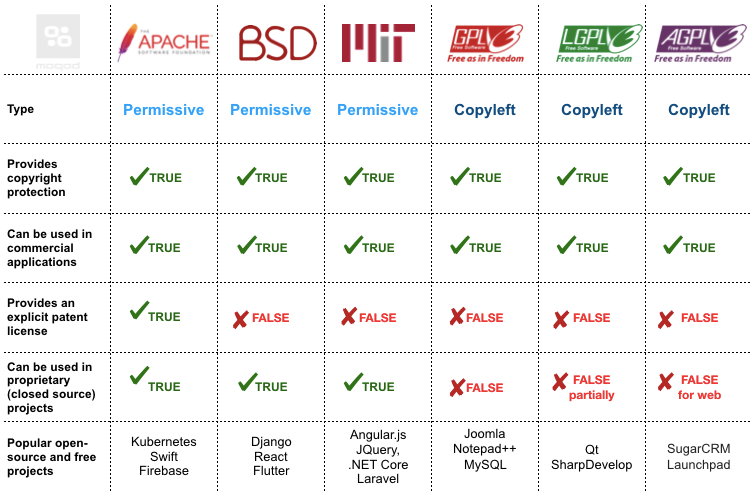Choosing an Open-Source License
Permissive vs. Copyleft
Before deciding on an open source license, you will need to understand which overall open source strategy you will be choosing: Permissive or Copyleft.
Permissive Licensing Strategy
- Simple, relaxed, (usually) low-risk I.P.
- You have strict timelines, short staff, and not a lot of time to build consensus: Permissive governance model match-up.
- You lead your I.P. and maintain tighter controls on decision-making.
- You value easier use and adoption of your open source products.
Examples of Permissive Licenses: MIT License, Apache License, any BSD-variant license, CC BY.
Threats:
- Little to no strings attached. It is easy for anyone else to do almost anything they want, provided they give attribution.
- Easy to be disrupted. Someone can take your work and remix or recreate into something that out-competes or out-resources your product.
Benefits:
- No legal team required. You do not need to invest a lot of resources into compliance. Pick something up and carry on your way.
- Adapting to a hybrid open and closed technology environment. Easier to mix and match open and closed source technologies.
- Encourages easier adoption of your software.
Copyleft Licensing Strategy
- Community-driven, core components of I.P.
- You can find flexibility in timelines, have a diverse staff, and would be aided by community participation: Copyleft governance model match-up
- The I.P. leads you and decision-making is aided --- maintain tighter controls on decision-making.
Examples of Copyleft Licenses: GPL-3.0 or other variants (LGPL, AGPL), Mozilla Public License (MPL), CC BY-SA, and a few others
Threats:
- Not everyone likes copyleft. Big Tech may have incompatible business models, and governments/NGOs may have legacy tech that is difficult to comply with copyleft.
- Requires up-front investment into community development.
Benefits:
- Rally external people together in a central community. The contributing dynamic changes because people are incentivized to contribute back.
Software Licenses
For software licenses, there are a number of acceptable licenses depending on your use case, including the GNU General Public license, the MIT license, or the BSD license.

Hardware Licenses
Open-source hardware refers to tangible objects such as machinery, mobile technology and other devices whose designs and other documentation for how to build the hardware are licensed under an open source license. Open source hardware designs, documentation, and bill of materials are available in a public repository so that they can be modified, changed or distributed.
For hardware licenses, we recommend the CERN, MIT, or TAPR Open Hardware Licenses.
For now, we will simply cover the CERN Open Hardware License, or OHL, developed by the CERN European Organization for Nuclear Research. It is to be included alongside the hardware design documentation files.
The CERN OHL allows anyone to see, study, modify, and share the design documentation for the piece of hardware to which it applies. See here for examples.
If modifications are made and distributed, it must be under the same license conditions – this is the ‘persistent’ nature of the license, which ensures that the whole community will continue benefiting from improvements, in the sense that everyone will in turn be able to make modifications to these improvements.
Content Licenses
If you are producing content you would like to share and create openly, Creative Commons provides serveral licenses that can be used for open content. Here are three of their licenses that can be used on open content with descriptions from the Creative Commons website:
- CC BY: This license allows reusers to distribute, remix, adapt, and build upon the material in any medium or format, so long as attribution is given to the creator. The license allows for commercial use.
- CC BY-SA: This license allows reusers to distribute, remix, adapt, and build upon the material in any medium or format, so long as attribution is given to the creator. The license allows for commercial use. If you remix, adapt, or build upon the material, you must license the modified material under identical terms.
- CC0 (aka CC Zero) is a public dedication tool, which allows creators to give up their copyright and put their works into the worldwide public domain. CC0 allows reusers to distribute, remix, adapt, and build upon the material in any medium or format, with no conditions.
Data Licenses
- Open Data Commons Licenses
- If maximum re-use is important, many datasets use CC0.
F.A.Q.
Q: How long does it take to adopt an open source license?
A: You can pick anything that is approved by the Open Source Initiative because it complies with the Common Open Source definition. You can take the text directly and include it in the root directory your project.
Q: Is it okay to finish developing your product before going to acquire a license?
A: Work with open source licenses as soon as you can, because it affects how you build your technology. If you're just getting started and which open source strategy (permissive vs copyleft), the sooner you get your license, you can build up your community and licensing approach and leveraging those benefits as well.
Open Licenses Resources
- Slides of Open Source Licensing Webinar (Open Source Licensing – an introduction by Justin Flory)
- Creative License Chooser: This guide will facilitate you through the relevant steps needed to decide and select the appropriate license for your open content project.
- Open Source Initiative Licenses: The updated list of licenses that have been approved by the Open Source Initiative (OSI).
- Other DPG General Licensing Resources
- Choose a License